Students and Vaping
The popularity of e-cigarettes and vaping among students has ballooned almost out of control. But teens often have too little information or rely on misinformation about vaping. Once teens look at the risks and understand the facts about e-cigs, they can head off years or even a lifetime of potential health problems.
E-cigarettes, or e-cigs, have been the most widely used tobacco product among teens since 2014. The federal government estimated that more than 3.6 million middle and high school students used e-cigs in 2018.
The number of teens vaping grew 900 percent from 2011 to 2015. Surgeon General Jerome Adams has called it an “epidemic of youth e-cigarette use.”
Health researchers have found that teens are exposed to a lot of information about the risks of traditional tobacco products. But researchers worry that public health experts may not be giving teens enough information about e-cigarettes, their risks and what’s in the e-liquids.
Teens may not know that the most popular brand of e-cigarette, JUUL, is in fact an e-cigarette.
Is JUUL an E-Cigarette?
JUUL is the top-selling e-cigarette brand in the United States. More than three in every four e-cigs sold in the United States is made by JUUL Labs Inc.
Each device resembles a USB flash drive and uses a pod of e-liquid or “juice” that contains nicotine, flavorings and other chemicals.

Public health experts have discovered that many teens consider the brand to be an entirely different device from an e-cigarette. Some teens also used the term “JUULing” instead of “vaping,” again considering the two as completely different activities.
But JUULs are e-cigarettes, and JUULing is the same as vaping.
5 Brands Accounted for 97% of E-cig Sales in 2018
- JUUL
- Vuse
- MarkTen
- Blu
- Logic
Health officials survey teens every year about nicotine use. The National Youth Tobacco Survey in 2019 was the first to list JUUL devices specifically as e-cigarettes. A researcher with the U.S. Centers for Disease Control and Prevention told The Los Angeles Times that he believed the simple change in language could reveal even more teen e-cigarette use.
Vaping Health Risks for Teens and Young Adults
Vaping poses particular risks for teens and young adults. At the same time, e-cig advertising reaches a substantial number of teens, and the e-liquids that put the vapor in vaping come in teen-friendly flavors.
The surgeon general’s 2019 advisory on youth vaping declared that “any e-cigarette use among young people is unsafe.” That’s partly because teens and young adults are susceptible to greater risks from vaping than older adults are.

Added Risks for Young People Compared to Older Adults
- People younger than 25 years old have a greater risk of brain damage from vaping.
- Younger people have a greater risk of becoming addicted to nicotine from vaping.
- Young people who vape are more likely to take up tobacco cigarettes.
Substances You Inhale When You Vape
E-cigarette vapor usually contains fewer dangerous chemicals than tobacco smoke, but it is not harmless. Vaping still puts a lot of harmful substances into your lungs. And many of them can cause serious and permanent medical problems.
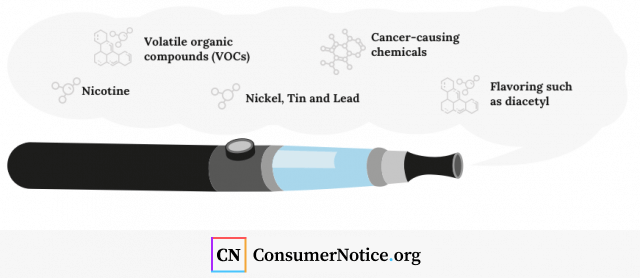
What’s in E-Cig Vapor?
- Nicotine
- Volatile organic compounds (VOCs) that can cause liver, kidney and nervous system damage
- Cancer-causing chemicals
- Heavy metals like nickel, tin and lead
- Flavoring such as diacetyl, a chemical linked to popcorn lung disease
Is There Nicotine in E-cigarettes?
Most teens don’t realize there’s nicotine in virtually all e-cigarettes. Almost all e-juices contain the highly addictive chemical. A 2019 study in the journal Pediatrics found vaping teens inhale as much nicotine as smokers, but don’t realize it.
The researchers found that 40 percent of teens who thought they were vaping nicotine-free products were actually inhaling nicotine. The researchers also found that teens who used e-cigarettes more frequently showed more nicotine in their systems.
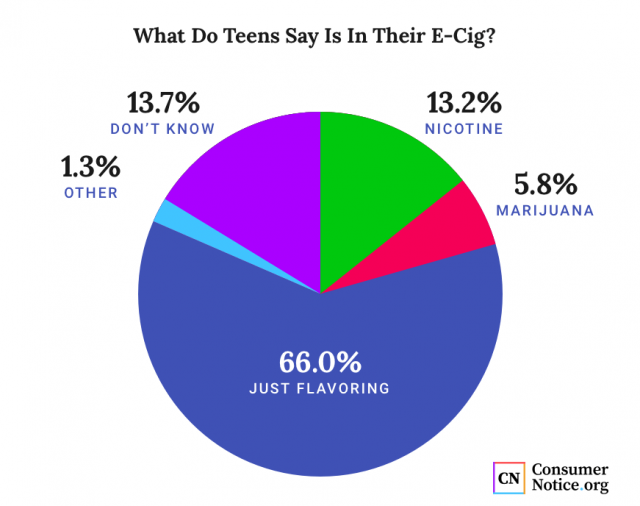
A 2018 study in the journal Tobacco Control found that 63 percent of young people who used JUUL e-cigarettes didn’t know that all JUUL products contain nicotine.
“All JUUL e-cigarettes have a high level of nicotine,” the CDC reports. “According to the manufacturer, a single JUUL pod contains as much nicotine as a pack of 20 regular cigarettes.”
“All JUUL e-cigarettes have a high level of nicotine. According to the manufacturer, a single JUUL pod contains as much nicotine as a pack of 20 regular cigarettes.”
In 2019, researchers at Stanford University wrote in Tobacco Control that JUUL’s introduction touched off a “nicotine arms race” among e-cigarette makers to cram the most nicotine they can into their products.
Before JUUL came out, most vaping liquids were only 1 percent to 3 percent nicotine. That may not sound like much, but those 3 percent e-juices were marketed to heavy tobacco users who smoked two packs a day.
When JUUL hit the market in 2015, it came with a 5 percent dose of the chemical. By 2019, other e-cig and e-liquid makers competing with JUUL had ramped up their nicotine content to as high as 7 percent, according to CNN.
Is Vaping Addictive?
The Stanford researchers said nicotine levels that high make e-cig pods “potentially addictive” to teens.
JUUL products use nicotine salts. These allow the user to inhale more nicotine more easily and with less irritation than they could with free-base nicotine that’s traditionally used in tobacco products, including e-cigarettes. The surgeon general warns that this can make it easier for a user to become nicotine dependent.
Having uncontrollable cravings to vape or smoke
- Having uncontrollable cravings to vape or smoke
- Feeling anxious or irritable if you can’t vape or smoke
- Giving in to vaping or smoking because you find it hard to stop
Nicotine addiction can strip teens of their willpower to quit vaping. NBC News reported about a 15-year-old who required rehab to break his JUUL habit. Luka Kinard of North Carolina was spending $150 a week on vape pods before he sought help. He suffered a seizure and spent 40 days in rehab before kicking his vape habit.
Several parents have also started filing e-cigarette lawsuits against manufacturers after their teens developed nicotine addiction. Lawyers are accepting cases on behalf of people who used Juul e-cigarettes while they were under 18 and became addicted or had health problems such as lung problems or seizures. In addition, people injured by Juul vaporizers that exploded or caught fire may also file lawsuits.
In September 2022, Juul agreed to pay nearly $440 million to 33 states to settle allegations from an investigation that found its marketing tactics targeted teens. In December 2022, Juul agreed to settle about 5,000 lawsuits for an undisclosed amount. The settlement included about 10,000 plaintiffs. A few days after the announcement, Bloomberg’s sources said the settlement amount was $1.2 billion.
In March 2023, the city of Chicago reached a $23.8 million settlement with Juul over allegations that the e-cigarette maker used deceptive marketing and sold its products to minors.
Dangers of Nicotine
Nicotine is especially dangerous to young people because it can harm still-developing brains. The brain isn’t fully developed until a person is about 25 years old. When you inhale nicotine, it goes straight to the brain in as little as 10 seconds. It activates parts of the brain that make you feel happy and satisfied.
But if your brain is still developing, nicotine can damage the parts of it that regulate your ability to learn new things, pay attention and control your impulses.
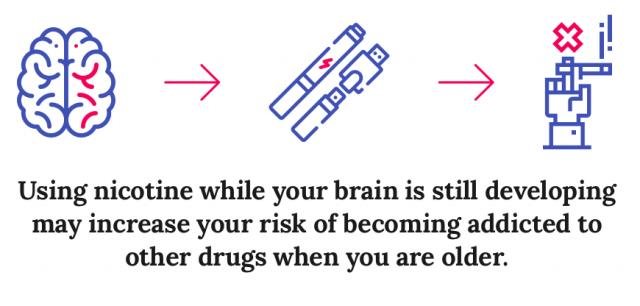
Nicotine does this by rewiring your brain. Normally, every time you learn some new skill or create a new memory, you build stronger connections between brain cells. These are called synapses. Nicotine changes the way your brain creates synapses.
This rewiring can have serious long-term consequences. Using nicotine while your brain is still developing can increase your risk of developing a psychiatric condition when you are older. It may also damage your ability to remember things, concentrate or make your own decisions later in life.
Is Vaping Safer Than Smoking?
Some evidence suggests that e-cigarettes may be less harmful than smoking tobacco. Regular cigarettes release 7,000 chemicals as they burn, including 70 that cause cancer, according the American Cancer Society.
They may be safer for adults who already smoke, but e-cigarettes are not safe for teens, young adults, pregnant women and people who don’t already use tobacco products, according to the CDC.
Risks from both vaping and smoking can be closely related for teens and young adults.
There’s not a lot of research on the long-term consequences of vaping because e-cigarettes have only been around since 2007. But there’s evidence that even short-term vaping can cause issues with lung function. And teens who use e-cigarettes are more likely to take up smoking, which can lead to long-term health problems.
A 2015 study in the Journal of the American Medical Association found that teens who used e-cigarettes were more than three times more likely than non-users to start smoking tobacco within six months.
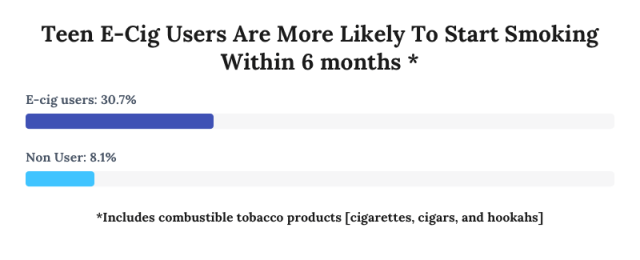
In 2018, researchers at Yale University discovered the transition to tobacco may happen even more quickly. They found a direct link between students who say they used an e-cigarette in the previous month and those who went on to smoke tobacco cigarettes.
Partly because nicotine can rewire developing brains to make them more susceptible to addiction, putting off vaping may prevent you from becoming addicted to nicotine and cigarettes. The CDC suggests that most people who don’t start smoking before their mid-20s never will.
Other Side Effects of Vaping
- Popcorn Lung Disease
- Harvard researchers found a chemical called diacetyl in nearly four of every five e-juice brands they tested. Diacetyl is known to cause bronchiolitis obliterans when inhaled, according to the American Lung Society. The serious and irreversible lung disease is also called popcorn lung disease. Scaring of the tiny air sacs in the lungs causes them to thicken and narrow airways. Symptoms include wheezing, coughing and difficulty breathing.
- Seizures
- In 2019, the FDA released information about reports of seizures that may have been caused by vaping. Among the 35 cases of seizures reported to the agency between 2010 and early 2019, many involved teens or young adults.
- Fires and Explosions
- All e-cigs rely on lithium ion batteries to power their heating elements. These batteries are small, lightweight and hold a charge for a long time. But they can also burst into flames or explode if they weren’t assembled properly at the factory or if they are damaged. Between 2009 and the end of 2016, the U.S. Fire Administration documented 195 fires and explosions involving e-cigs. More than 120 incidents happened while the e-cigs were in use or in the user’s pocket.
E-Cig Advertising Targets Teens
Nearly seven in 10 middle and high school students regularly see ads for e-cigarettes, according to the CDC. The agency believes that heavy exposure to ads in stores, on the internet, in magazines, on TV and in movies may be driving the increase in teen vaping.
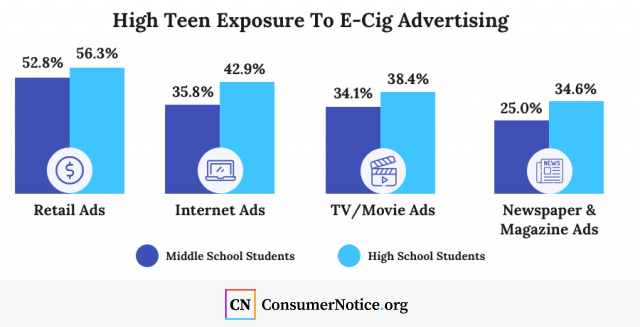
JUUL Labs publicly supports raising the legal age for purchasing its products to 21 years old. But it has made use of marketing strategies that appear targeted at teens.
A research team at Stanford University examined thousands of JUUL’s ads in emails, Instagram posts and conventional advertisements. They concluded the company’s marketing campaigns in JUUL’s first six months were “patently youth-oriented.”
The company aggressively used social media to market its e-cigs and pods until the FDA pressured JUUL to shut down its Facebook and Instagram accounts in November 2018.
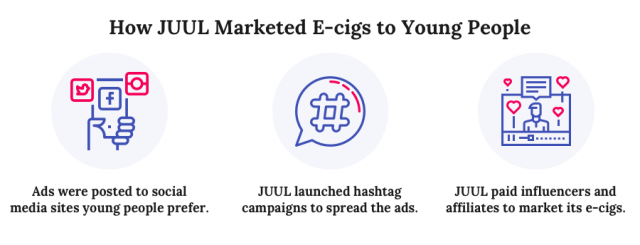
The researchers also found the company handed out free JUUL e-cigs to youthful influencers at sampling parties and movie or music events during its 2015 product launch. The company followed up with aggressive advertising featuring 20-something models to appeal to younger customers.
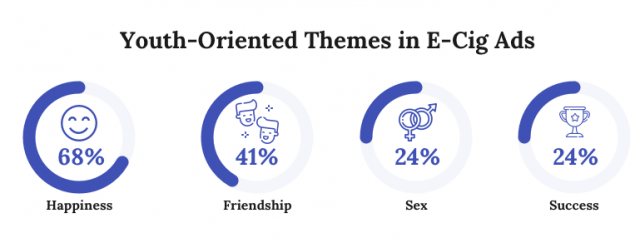
The company toned down its ads targeting youth about six months after JUUL launched, but it still didn’t feature older adults in its marketing. JUUL’s advertising rebooted again in 2018 as government regulators and public health officials raised alarms about its marketing. It shifted from youth-related themes to more ads about helping older adults stop smoking.
How to Know If Your Student Is Vaping
About one in every five high school students and one in 20 middle school students vaped in 2018, according to the U.S. Surgeon General’s advisory.
You can spot signs that your teen is vaping if you know what to look for. Chemicals in e-liquids can affect a teen’s behavior, cause dehydration and reduce some senses, such as taste and smell. These may be clues of e-cig use.
10 Signs Your Teen May Be Vaping
- Decreased caffeine use
- Desire for spicy, salty or more flavorful foods
- Disappearing money
- Finding vaping equipment, packaging or materials
- Increased secrecy
- Increased thirst
- Mood changes or increased irritability
- Nosebleeds
- Unusual scents
- Unwillingness to stay home
Parents need to understand why their teen may be drawn to vaping. Teens may take up vaping for a variety of reasons. Curiosity, kid-friendly flavors and boredom top the list, according to the Partnership for Drug Free Kids.
How to Talk to Your Teen About Vaping
Talking to your teen may be the most important thing you can do to prevent or stop a vaping habit. Addiction experts and medical professionals stress the importance of honest and open discussions. It’s vital to plan ahead for that conversation.
- Learn
- Understand the risks of teen vaping. Familiarize yourself with different types of e-cigarettes and e-liquids. Re-read this guide to learn more.
- Ask Questions
- “What do you think about vaping?” is an open-ended question parents can use to start the discussion, according to the Partnership for Drug-Free Kids. “Do kids at your school vape?” is another. “What’s your experience with kids vaping at your school?” is a different conversation starter the Child Mind Institute suggests.
- Listen
- Teens may shut down during a lecture when they think you’re criticizing them. Any discussion has to be two-way. Listen to their side and understand your teens’ questions, concerns and explanations. Talk about why they may want to change their behavior rather than ordering them to.
- Be Honest
- Explain the risks of vaping and exactly why you don’t want your teens vaping. Explain how nicotine and other vape chemicals can affect the brain, hurting their grades and social life.
- Be a Role Model
- If you are a former smoker, explain why you quit, how difficult it may have been and why you don’t want them to go through the same thing. If you still smoke, use this as a reason to quit.
The U.S. Surgeon General and the CDC offer a tip sheet with more ideas about how to plan and have a conversation about vaping. It also provides questions to expect from your teen and ideas for how to best answer them.
35 Cited Research Articles
Consumernotice.org adheres to the highest ethical standards for content production and references only credible sources of information, including government reports, interviews with experts, highly regarded nonprofit organizations, peer-reviewed journals, court records and academic organizations. You can learn more about our dedication to relevance, accuracy and transparency by reading our editorial policy.
- Rajesh, A.M. (2023, March 10). Juul reaches settlement with Chicago for nearly $24 mln. Retrieved from https://www.reuters.com/legal/juul-reaches-settlement-with-chicago-nearly-24-mln-2023-03-10/
- Feeley, J. & Malathi, N. (2022, December 9). Juul Agrees to Pay $1.2 Billion in Youth-Vaping Settlement. Retrieved from https://www.bloomberg.com/news/articles/2022-12-09/juul-to-pay-1-2-billion-in-youth-vaping-settlement
- Babu, J. & Kirkham, C. (2022, December 7). E-cigarette maker Juul reaches settlement with nearly 10,000 plaintiffs. Retrieved from https://www.reuters.com/legal/e-cigarette-maker-juul-reaches-settlement-with-nearly-10000-plaintiffs-2022-12-07/
- Jewett, C. (2022, September 6). Juul Settles Multi-State Youth Vaping Inquiry for $438.5 Million. Retrieved from https://www.nytimes.com/2022/09/06/health/juul-settlement-vaping-crisis.html
- American Academy of Pediatrics. (2018, April 17). JUULING: Get the Facts. Retrieved from https://www.healthychildren.org/English/health-issues/conditions/tobacco/Pages/Juuling-Get-the-Facts.aspx
- American Cancer Society. (2018, November 21). What Do We Know About E-cigarettes? Retrieved from https://www.cancer.org/cancer/cancer-causes/tobacco-and-cancer/e-cigarettes.html
- American Lung Association. (2016, July 7). Popcorn Lung: A Dangerous Risk of Flavored E-Cigarettes. Retrieved from: https://www.lung.org/blog/popcorn-lung-risk-ecigs
- Beaumont Health. (n.d.). Vaping Dangers, Discussion with Teens Necessary. Retrieved from https://www.beaumont.org/health-wellness/blogs/dangers-of-vaping
- Becker, R. (2018, November 21). JUUL’s Nicotine Salts Are Dominating the Market – and Other Companies Want In. The Verge. Retrieved from https://www.theverge.com/2018/11/21/18105969/juul-vaping-nicotine-salts-electronic-cigarettes-myblu-vuse-markten
- Becker, R. (2019, February 8). Juul’s Imitators Are Copying the Popular Vape’s High Nicotine Levels. The Verge. Retrieved from https://www.theverge.com/2019/2/8/18217738/juul-vape-nicotine-salts-electronic-cigarette-competitors
- Belluz, J. (2019, January 25). The Vape Company JUUL Said It Doesn’t Target Teens. Its Early Ads Tell a Different Story. Vox. Retrieved from https://www.vox.com/2019/1/25/18194953/vape-juul-e-cigarette-marketing
- Boykan, R., et al. (2019, April). Self-Reported Use of Tobacco, E-cigarettes, and Marijuana Versus Urinary Biomarkers. Pediatrics. Retrieved from https://pediatrics.aappublications.org/content/143/5/e20183531
- British American Tobacco. (n.d.). Overview of Our Portfolio. Retrieved from https://www.bat.com/brands
- Center for Responsive Politics. (2018, September). Electronic Cigarettes. OpenSecrets.org. Retrieved from https://www.opensecrets.org/news/issues/e-cigarettes/
- Dunn, L., Fox, M, and Beck, C. (2019, January 8). Vaping Sent This Teenager into Rehab. His Parents Blame JUUL’s Heavy Nicotine Dose. NBC News. Retrieved from https://www.nbcnews.com/health/health-news/vaping-sent-teenager-rehab-his-parents-blame-juul-s-heavy-n956356?icid=related
- Goriounova, N.A. and Mansvelder, H.D. (2012, December). Short- and Long-Term Consequences of Nicotine Exposure During Adolescence for Prefrontal Cortex Neuronal Network Function. Cold Spring Harbor Perspectives in Medicine. Retrieved from https://www.ncbi.nlm.nih.gov/pmc/articles/PMC3543069/
- Ho, C. (2019, April 22). Mounting Lawsuits Against JUUL Reminiscent of Early Tobacco Litigation. San Francisco Chronicle. Retrieved from https://www.sfchronicle.com/business/article/Mounting-lawsuits-against-Juul-reminiscent-of-13783089.php?psid=w2fs
- Imperial Brands. (n.d.). ITG Brands. Retrieved from https://www.imperialbrandsplc.com/About-us/Our-companies/ITG-Brands.html
- Jackler, R.K. and Ramamurthi, D. (2019, February 6). Nicotine Arms Race: JUUL and the High-Nicotine Product Market. Tobacco Control. Retrieved from https://www.ncbi.nlm.nih.gov/pubmed/30733312
- Jackler, R.K., et al. (2019, January 31). JUUL Advertising Over Its First Three Years on the Market. Stanford Research Into the Impact of Tobacco Advertising. Retrieved from https://tobacco-img.stanford.edu/wp-content/uploads/2021/07/21231836/JUUL_Marketing_Stanford.pdf
- LaVito, A. (2018, December 10). Altria Shutters Its E-cigarette Brands as it Eyes JUUL, Awaits iQOS Decision. CNBC. Retrieved from https://www.cnbc.com/2018/12/07/altria-closes-e-cigarette-brands-as-it-eyes-juul-awaits-iqos-decision.html
- LaVito, A. (2018, December 20). Tobacco Giant Altria Takes 35% Stake in JUUL, Valuing E-cigarette Company at $38 Billion. CNBC. Retrieved from https://www.cnbc.com/2018/12/20/altria-takes-stake-in-juul-a-pivotal-moment-for-the-e-cigarette-maker.html
- LaVito, A. (2018, November 30). JUUL Said It Wasn’t Big Tobacco. Now It’s Considering Money from the Maker of Marlboro. CNBC. Retrieved from https://www.cnbc.com/2018/11/30/juul-e-cigarette-maker-weighs-investment-frommarlboro-maker-altria.html
- Martinelli, K. (n.d.). Teen Vaping: What You Need to Know. Child Mind Institute. Retrieved from https://childmind.org/article/teen-vaping-what-you-need-to-know/
- Nedelman, M. and Selig, R. (2019, February 7). Juul Ramped Up Nicotine Levels, and Competitors Followed, Study Says. CNN Health. Retrieved from https://www.cnn.com/2019/02/07/health/juul-nicotine-arms-race-study/index.html
- Partnership for Drug-Free Kids. (n.d.). How to Talk With Your Kids About Vaping. Retrieved from https://drugfree.org/article/how-to-talk-with-your-kids-about-vaping/
- Raven, K. (2018, December 19). Teen Vaping Linked to More Health Risks. Yale Medicine. Retrieved from https://www.yalemedicine.org/news/teen-vaping
- Roditis, M.L. and Halpern-Felsher, B. (2015, June 23). Adolescents’ Perceptions of Risks and Benefits of Conventional Cigarettes, E-Cigarettes, and Marijuana: A Qualitative Analysis. Journal of Adolescent Health. Retrieved from https://www.sciencedirect.com/science/article/pii/S1054139X15001573
- Smokefree.gov. (n.d.). Nicotine & Addiction. Retrieved from https://teen.smokefree.gov/the-risks-of-tobacco/nicotine-addiction
- U.S. Centers for Disease Control and Prevention. (2019, February 28). Youth and Tobacco Use. Retrieved from https://www.cdc.gov/tobacco/data_statistics/fact_sheets/youth_data/tobacco_use/index.htm
- U.S. Centers for Disease Control and Prevention. (2019, March 11). Quick Facts on the Risks of E-cigarettes for Kids, Teens, and Young Adults. Retrieved from https://www.cdc.gov/tobacco/basic_information/e-cigarettes/Quick-Facts-on-the-Risks-of-E-cigarettes-for-Kids-Teens-and-Young-Adults.html#
- U.S. Centers for Disease Control and Prevention. (n.d.). E-Cigarettes Shaped Like USB Flash Drives: Information for Parents, Educators, and Health Care Providers. Retrieved from https://www.cdc.gov/tobacco/infographics/youth/pdfs/e-cigarettes-usb-flash-508.pdf
- U.S. Food and Drug Administration. (2018, September 12). Statement from FDA Commissioner Scott Gottlieb, M.D., on New Steps to Address Epidemic of Youth E-Cigarette Use. Retrieved from https://www.fda.gov/news-events/press-announcements/statement-fda-commissioner-scott-gottlieb-md-new-steps-address-epidemic-youth-e-cigarette-use
- U.S. Surgeon General. (n.d.). Talk With Your Teen About E-cigarettes: A Tip Sheet for Parents. Retrieved from https://e-cigarettes.surgeongeneral.gov/documents/SGR_ECig_ParentTipsheet_508.pdf
- Wallace, M. and Stuch-Girard, C. (n.d.). Teens and Vaping: What You Should Know. Student Health 101. Retrieved from https://hs.studenthealth101.com/teens-and-vaping/
Calling this number connects you with a Consumer Notice, LLC representative. We will direct you to one of our trusted legal partners for a free case review.
Consumer Notice, LLC's trusted legal partners support the organization's mission to keep people safe from dangerous drugs and medical devices. For more information, visit our partners page.
844-420-1914

